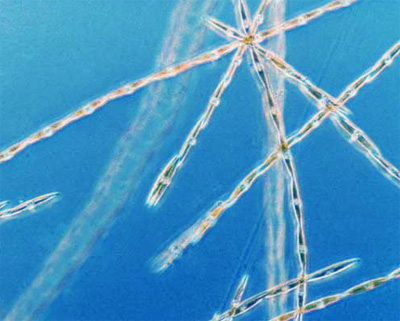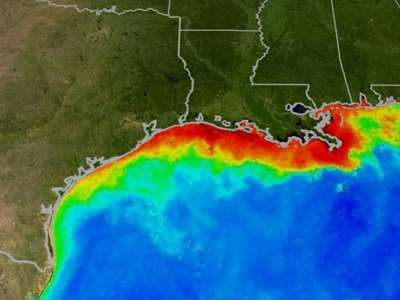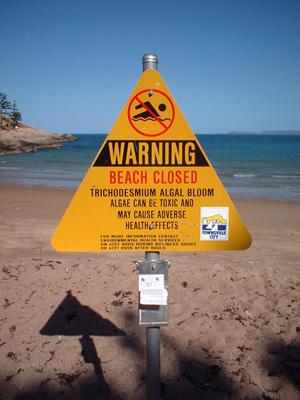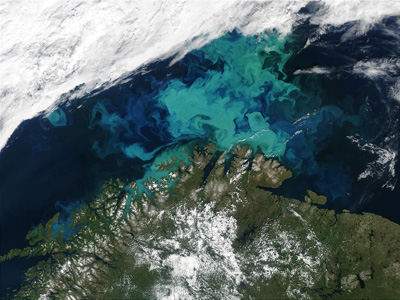3. Eutrophication & Health (3/5)
Algal blooms
An algal bloom or marine bloom or water bloom is a rapid increase in the population of algae in an aquatic system. They may occur in freshwater as well as marine environments.

Source: NOAA
Typically only one or a few phytplankton species are involved and some blooms may be recognized by discoloration of the water resulting from the high density of pigmented cells. Colours observed are green, yellowish-brown, or red.
Although there is no officially recognized threshold level, algae can be considered to be blooming at concentrations of hundreds to thousands of cells per milliliter, depending on the causative species. Algal bloom concentrations may reach millions of cells per milliliter.
Sometimes blooms are bright green, these are a result of blue-green algae, which are actually bacteria (cyanobacteria). Eutrophication (particularly increases in the nutrients phosphorus and nitrogen) is a major cause of algal blooms. An excess of nutrients in waters causes increased growth of algae and green plants.
As more algae and plants grow, others die. This dead organic matter becomes food for bacteria that decompose it. With more food available, the bacteria increase in number and use up the dissolved oxygen in the water. When the dissolved oxygen content decreases, many fish and aquatic insects cannot survive. This results in a dead area.

Source: NASA
Algal blooms may also be of concern as some species of algae produce neurotoxins. At the high cell concentrations reached during some blooms, these toxins may have severe biological impacts on wildlife.
Harmful algal blooms
Most algae are not harmful even when they form blooms that are sometimes seen in rivers, estuaries and the ocean. A small percentage of algae, however, produce powerful toxins that can kill fish, shellfish, mammals and birds, and may directly or indirectly cause illness in people. These Harmful algal blooms (HABs) have been reported in almost every coastal zone, and their occurrence may be on the rise. The problem is of great concern because HABs can adversely affect not only the health of people and marine organisms, but also the "health" of local and regional economies.
Threats to Humans
The human illnesses caused by HABs, though rare, can be debilitating or even fatal. The person grows ill after consuming seafood that is tainted from the ingestion of biotoxin-producing algae. These syndromes include ciguatera fish poisoning and neurotoxic, diarrhetic, paralytic and amnesic shellfish poisoning.

One well-documented neurotoxin occurring in tainted shellfish is domoic acid, which can lead to amnesic shellfish poisoning in people and marine mammals and sea birds. The organisms causing this are diatoms in the genus Pseudo-nitzschia. They produce domoic acid which accumulates in the tissues of mussels, crabs, and fish. After consuming the tainted seafood, the affected person usually develops gastrointestinal distress, sometimes followed by confusion, memory loss, disorientation, and in extreme cases, coma and death. There is no antidote for this toxic, the patient either recovers or succumbs to the poison.
HABs are costly not only in health terms but in economic ones as well. They cause about huge economic losses to the seafood, restaurant and tourism industries each year. HABs reduce tourism, close beaches and shellfish beds, and decrease the catch from both recreational and commercial fisheries.
Red Tide

Source: NOAA
Perhaps the best known HAB is the so-called “red tide” that occurs nearly every summer along Florida’s Gulf Coast, and that Spanish explorers first observed in the 16th century. The organism that causes the Florida red tide (which may not always appear red), a microscopic algae called Karenia brevis, produces a toxin that makes shellfish dangerous to eat. It also kills fish, and in some instances, dolphins and manatees. It may also make the surrounding air difficult to breathe due to aerosolized toxins. Scientists have been monitoring and studying the phenomenon for a number of years, including remote sensing, to determine how to detect and forecast the location of the blooms. The goal is to give communities advance warnings so they can adequately plan and deal with the adverse environmental and health affects associated with these red-tide events.

